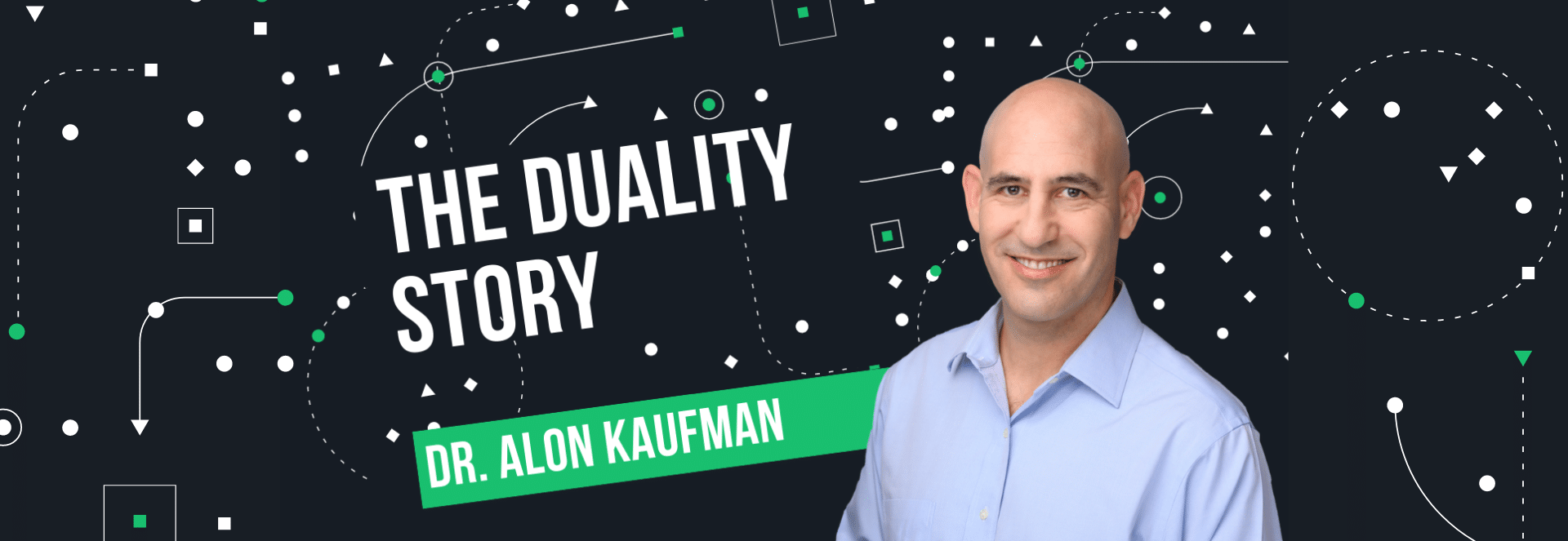Dr. Alon Kaufman, CEO and Co-founder of Duality Technologies, describes his path to PETs and the Duality story.
What led you to founding Duality?
[Alon Kaufman] I am a data scientist and have been in the industry since completing my PhD over 20 years ago. Throughout my career the number one challenge that repeatedly came up was: how can a business derive value and insights from their data? This business challenge is especially relevant when one must combine data from multiple sources within the organization, across geographies or even across companies. Discovering new insights by combining data sources or data from different domains served me very successfully throughout my career. For example, in the field of brain research, having the ability to combine data coming from fMRI scans with data from behavioral tests for stroke patients was key for research of rehabilitation and recovery from strokes. In the biology space, combining gene expression data with DNA knockouts helped to identify the function of specific genes; and during my time at RSA, we combined data from multiple banks to build models for detecting financial fraud. All these use cases may seem wildly different, however there was and is one common thread: the power of data collaboration. Time and again we saw that even if you take the most sophisticated machine learning model and train it on just one data source, the resulting model will be vastly inferior to taking a very simplistic model and training it on data from multiple sources. Hence, I strongly believe that any data strategy needs to have data collaboration as a key pillar.
No matter the task or query – data is at the root of most of our decision making today and continues to be the very backbone of our global economy. All of us, in our everyday lives, use data collaboration to help us make better decisions. For example, if you are in the market to purchase a new home, you will gather and analyze data, such as market prices, school district information, local taxes, traffic and transportation, and demographics from diverse domains. The more relevant data you can gather and analyze, the better decision you will be able to make.
The need for data collaboration recurred everywhere I went in my career, but it was during my time at RSA that it started to become evident to me that this ability to share and combine datasets is more fraught with challenges than we ever imagined, primarily due to the numerous privacy regulations that started to emerge and the growing importance of data confidentiality and protection of business insights.
The increased focus on data sharing, collaboration, and privacy, raises huge conflicts for data driven companies and enterprises alike. Data companies and enterprises want to use their data and collaborate effectively and efficiently, all while ensuring the utmost care is given to privacy and data protection. That dichotomy is at the heart of what led to founding Duality.
How was the Duality team formed?
[Alon Kaufman] This is an interesting story, and one that I really like. While I was at RSA and beginning to understand that there is this key business need to collaborate on data, in a parallel universe my amazing co-founders were working on a similar topic.
During my tenure at RSA, we were dealing with data collaboration challenges in the cybersecurity world. Fortunately, in one of my periodic meetings with Rina Shainski, now our Chairwoman, whom I had known for many years, we discussed the shared challenges we were running into in our respective roles. At the time she had already teamed up with world-renowned cryptographers who had achieved excellent results on groundbreaking technology that can allow users to analyze data while encrypted. Rina was so fascinated by the work they were doing, how it presented new opportunities in the data sharing and collaboration landscape, and its transformative potential that she decided to leave her role as a leading VC and start a company. The match was ideal. I was exposed to the actual business problem, and Prof. Shafi Goldwasser, Prof. Vinod Vaikuntanathan, and Dr. Kurt Rohloff, together with Rina Shainski, were developing the technology into a market-ready solution, and so Duality was born.
What makes Duality special?
[Alon Kaufman] What’s so special about Duality in this space is that we focus on enabling our customers to drive their business forward while utilizing sensitive data sets or remote datasets that they could not utilize before. Duality marries data science and data collaboration in a privacy preserving manner.
Today there is a growing ecosystem of companies that offer diverse types of privacy enhancing technologies (PETs). Some of these companies offer capabilities around the ability to compute on encrypted data using homomorphic encryption, which is our cornerstone. Others offer alternate capabilities, like generating synthetic data or applying federated learning. What is special about Duality is that instead of taking a technical approach, we take an enterprise view that is focused on helping businesses. We help our customers address their challenges using a variety of PETs. We are paving the path to enterprise-wide data collaboration capabilities, and we have a world class team of experts in both data science and cryptography working directly with our customers to find the best solutions to their unique business challenges.
Data and privacy are a serious business, and our customers rely on us for both our technology and expertise. We do not expect them to be experts, neither in analytics nor data privacy nor encryption. We expect them to use our solutions like they use any other kind of software or data science platform, with robust and inherent privacy tools embedded within.
How can data driven enterprises start implementing privacy enhancing technologies (PETs)?
[Alon Kaufman] This is an excellent question. The most innovative data driven companies have already started the process, and soon it will become the new standard for all enterprises. We can draw an analogy to the data science world of about 10 to 15 years ago; when companies were first starting to embrace data science and building their strategy around it. they were required to have some level of data maturity. Enterprises need to have a certain level of maturity; including understanding what business goals and challenges they have, translating this to data science needs, identifying what data they have, and how they plan to roll it out across the organization. Spring forward to today and nearly all organizations have a chief data scientist on their board, or as part of the executive team. The enterprises at the forefront of their markets are the ones most proficient at utilizing data to drive value.
If we take that analogy and apply it to PETs, privacy enhancing technologies must go through a similar maturation process. The first step in becoming a data driven enterprise is for companies to identify how a data collaboration strategy can help them address their business goals. Once the need is defined, they need to figure out the collaboration piece: to define where and how they would like to collaborate on data, with which other parties, and how or why they need to break down data silos within their organizations and across the competitive landscape.
The next step is to define and vet the tools that will enable them to execute that collaboration with privacy always at the forefront. Today this is a particularly challenging undertaking for enterprises because they have so many different technologies to consider. Each vendor offers a different approach and capabilities under the broad umbrella of privacy enhancing technologies. Some vendors offer only data anonymization, others may include the ability to analyze or create synthetic data, etc. Unfortunately, this cacophony of technologies and approaches is only creating more confusion for businesses.
What organizations really need is a single comprehensive platform that allows enterprises to analyze and collaborate on data while making sure the data is kept private and protected throughout the full data collaboration process. This platform also must enable compliance with regulatory requirements. Exactly as in the data science space, where one has different models for different use cases, PET models depend heavily on the use case. One PET will not suffice. Our platform enables enterprises to address their data collaboration needs more strategically, quickly, and efficiently without the need to be experts in the PETs field.
Watch the full video here:















